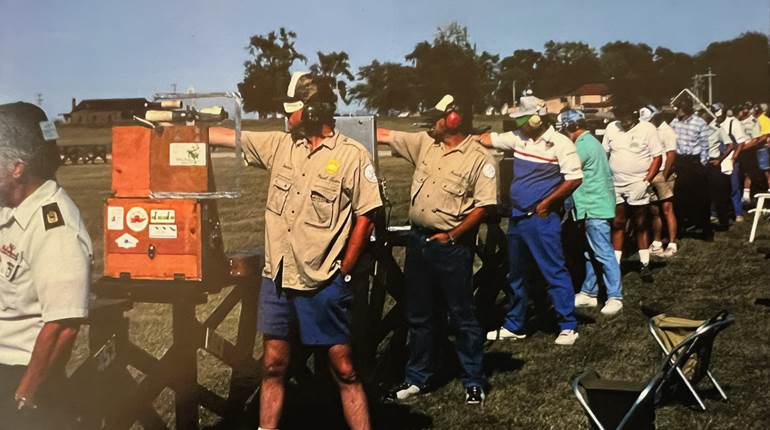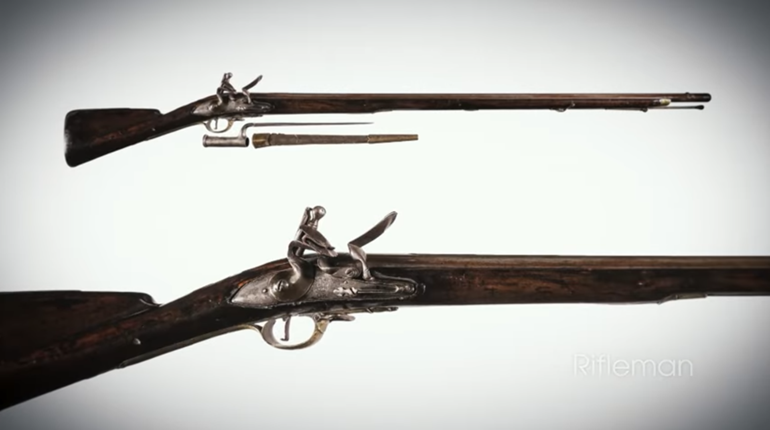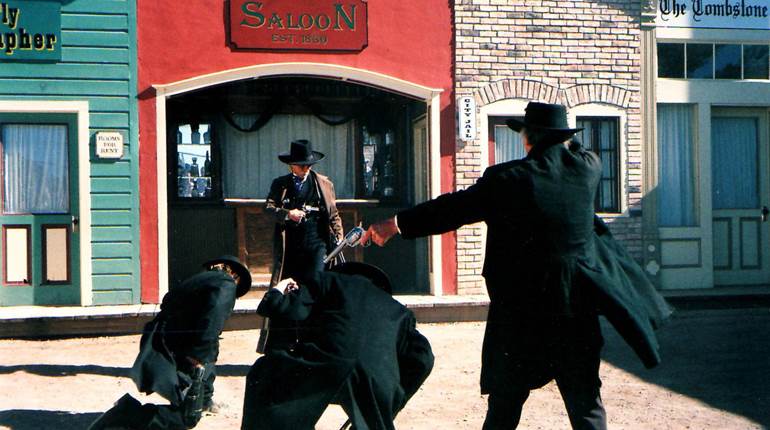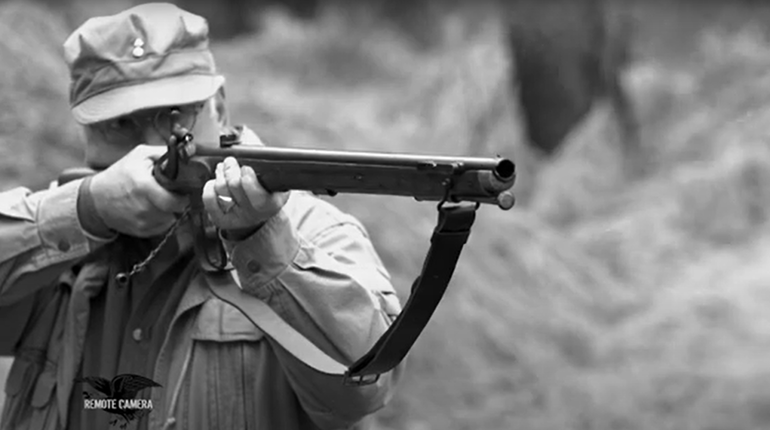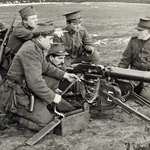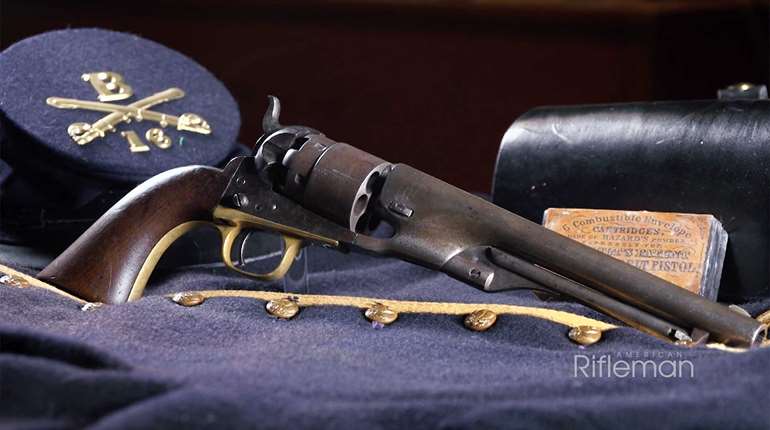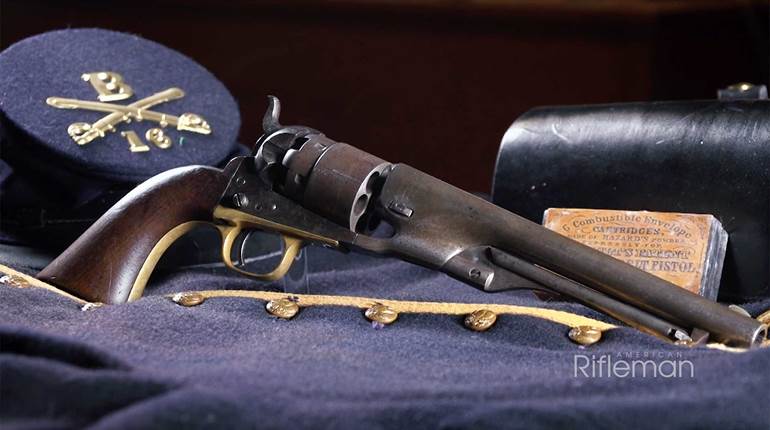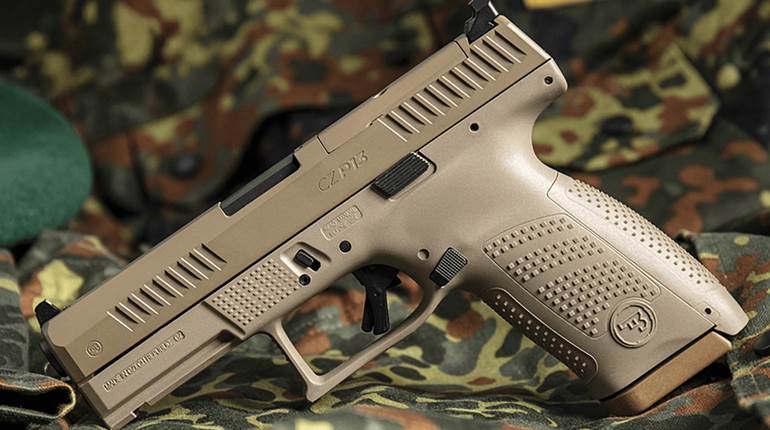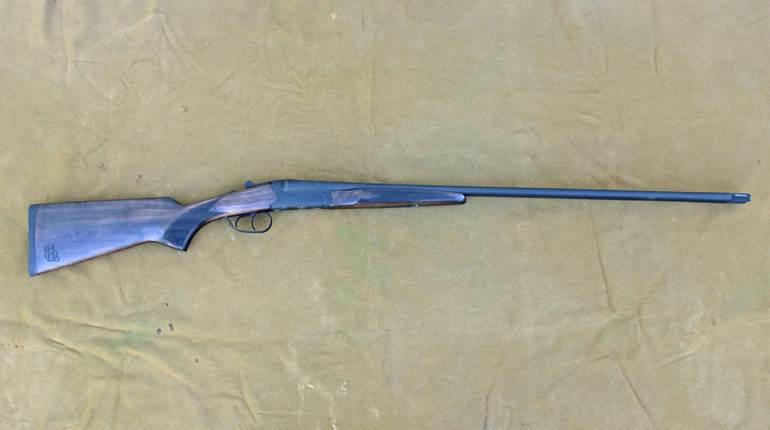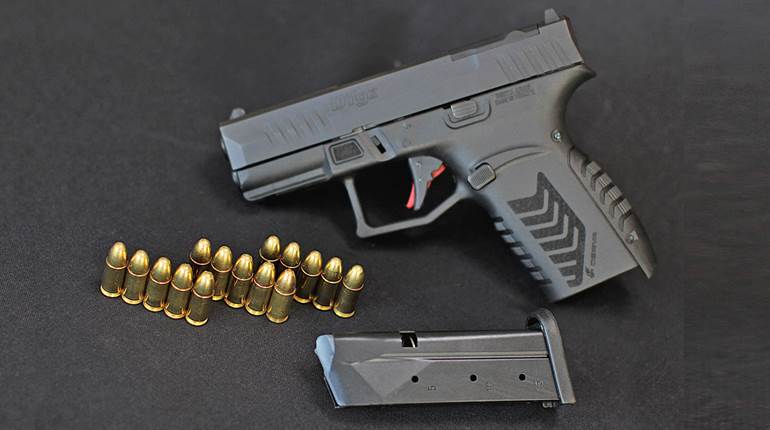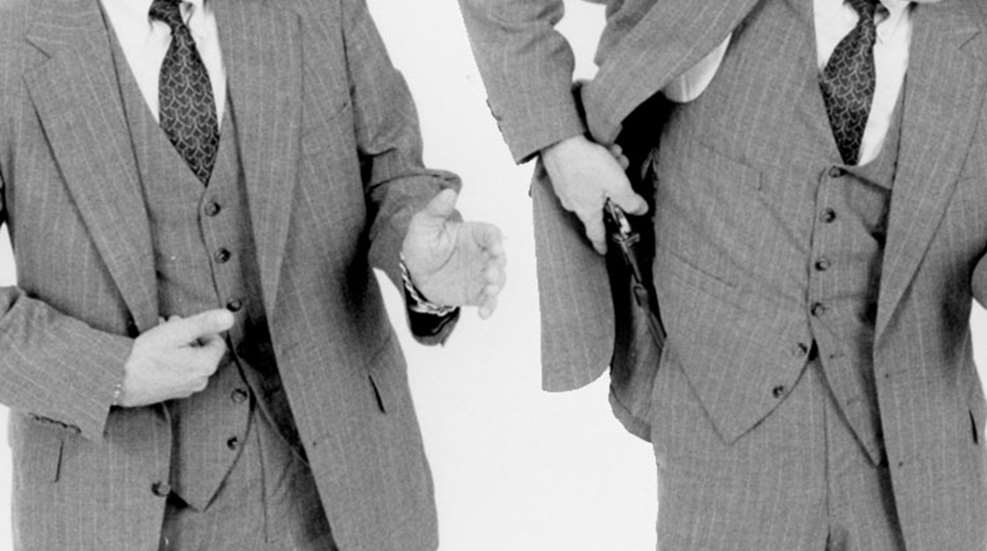
Originally published May 1986
By Bob R. Crovatto
Many law enforcement agencies in this country do not teach the concealed draw. There is a general perception that if an officer knows how to draw a pistol unconcealed, then he knows how to draw one from the concealed position. In my opinion the latter does not always follow the former.
I have carried a concealed pistol under a business suit or other "soft" clothing almost every day for the past 21 years. Learning to draw that pistol properly was a skill that had to be mastered, and I have long felt that greater emphasis should be devoted, not only to the "how" of the skill, but to the pitfalls inherent in this carry mode.
Concealment of one's pistol commences with an outer garment, such as a business suit, sportcoat or long square-tailed sportshirt, which is long enough fully to conceal the pistol and holster. I have attended IPSC matches billed as "concealment" type, where the officials permitted almost any type of jacket that made a partial attempt to cover the bolstered pistol.
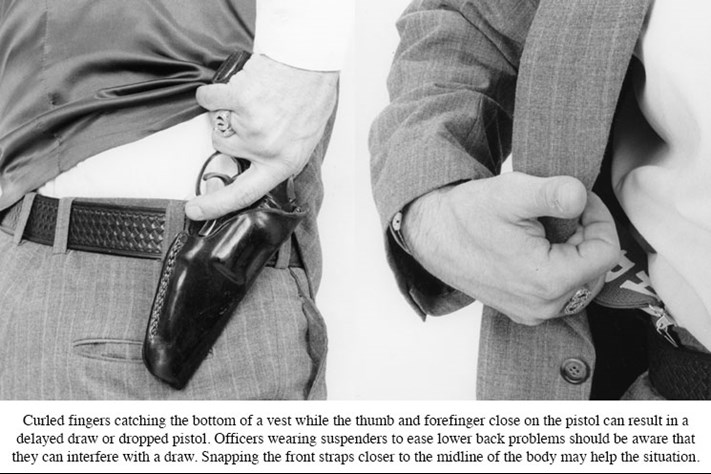 Denim cowboy jackets (Levi type) and other short-waisted types are not considered acceptable within the context of this writing. Similarly excluded are cross-draw and appendix rigs, which are worn forward of the hip bone either inside or outside of the trousers.
Denim cowboy jackets (Levi type) and other short-waisted types are not considered acceptable within the context of this writing. Similarly excluded are cross-draw and appendix rigs, which are worn forward of the hip bone either inside or outside of the trousers.
Suitcoats should be worn unbuttoned to allow for easy access to the pistol. No matter how long a suitcoat is, it is nearly impossible to conceal a pistol worn on the belt forward of the hip bone. Most cross-draw rigs, as a result, are worn behind the hip bone in a position which is so far to the rear that it does not permit the proper shooting grip to be obtained on the pistol while holstered. Not getting the shooting grip in the holster is a serious liability which necessitates an adjustment between leather and line-up, which means a loss of time.
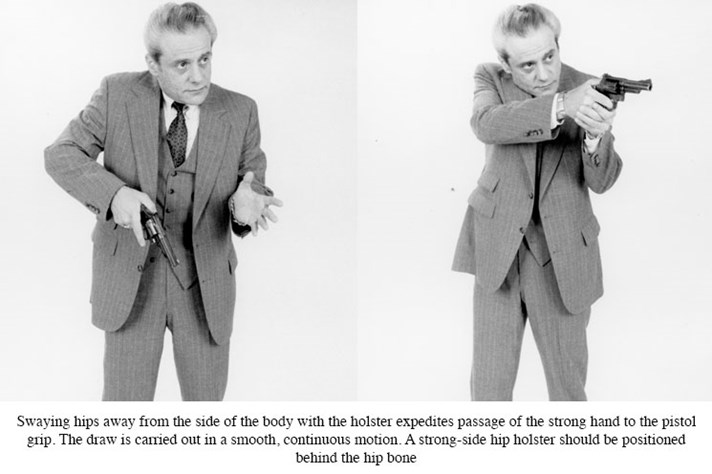 Often a proper adjustment is not made, " resulting in a ''weak" draw which hinders and impedes the accuracy and speed of both the initial and subsequent rounds. Recoil control is reduced by the "weak" grip, thus increasing recovery time between shots. In close defensive combat, accuracy and rapidity of fire are the critical factors.
Often a proper adjustment is not made, " resulting in a ''weak" draw which hinders and impedes the accuracy and speed of both the initial and subsequent rounds. Recoil control is reduced by the "weak" grip, thus increasing recovery time between shots. In close defensive combat, accuracy and rapidity of fire are the critical factors.
The selection of concealed holsters, like many other facets of shooting, is subjective. This attitude has probably helped to form a basis for an "official benign neglect" policy among some police administrators and firearms instructors. Directives requiring a particular holster for off-duty or non-uniformed wear fly in the face of changing fashion and personal liberties. For these reasons, occasionally these directives, if issued, are not vigorously enforced.
Based on 21 years of law enforcement experience, my opinion is that the best compromises (holster choices are all compromises between speed, safety and concealability) for business suit wear are; 1) a strong-side hip rig worn in the "FBI tilt" position behind the hip bone, 2) a flat of the back rig (for those who do not ride in vehicles), or 3) a shoulder holster (for those who do ride often in a vehicle). I recognize that these are not the only choices, but they are the most popular and logical based on my observations in working with police and federal agents over the years.
I'll readily admit that the cross-draw belt rig is popular, but I have never witnessed the wearer of one acquit himself well on the combat range unless he paused to rearrange the holster on his belt so that it was well forward of the hip bone, and then, of course, it no longer conceals well.
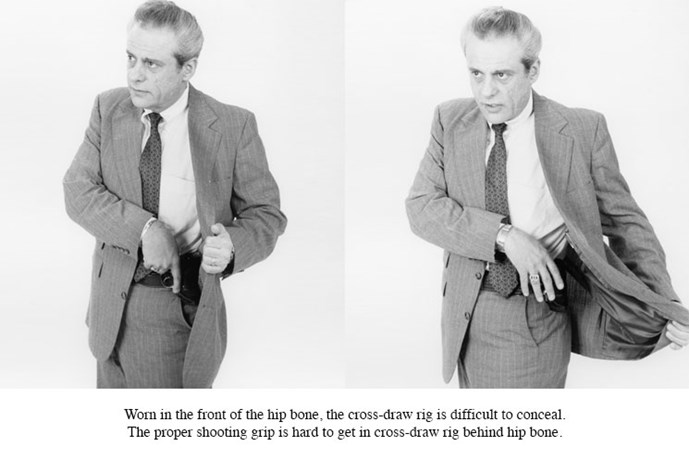 I am excluding crotch rigs, ankle, boot, and armpit rigs, etc., since they are highly specialized and a little off to one side of the more prevalent, everyday holsters that detectives, federal agents, bodyguards and licensed civilians are more likely to wear.
I am excluding crotch rigs, ankle, boot, and armpit rigs, etc., since they are highly specialized and a little off to one side of the more prevalent, everyday holsters that detectives, federal agents, bodyguards and licensed civilians are more likely to wear.
The procedure for the concealed draw is identical to that of the unconcealed draw except for the outer garment. The strong/(gun) hand sweeps under the garment in a smooth, quick and continuous movement to scoop the pistol from the holster and bring it to the desired shooting position—-close hip, Weaver, modified Weaver, isosceles, point shoulder, etc.
As previously mentioned, obtaining the shooting grip on the pistol in the holster is crucial. The knife-like outer edge of the; strong hand, small finger slightly flexed but at almost right angle to the palm, moves rearward between the jacket edge and the strong-side hip.
At the same time, the hips may be swayed to the opposite side of the body from the holstered pistol. This increases the size of the space between the jacket and the holstered pistol, facilitating the passage of the strong hand to the pistol grip. (Some prefer not to sway the hips, but I have never been as comfortable or as consistent performing the draw unless I do. Each person should try both ways to decide which method suits him best.)
The addition of a small weight in the pocket of the jacket provides a pendulum effect and retards the eventual inward movement of the jacket toward the hip. A cigarette lighter, key ring or loose change in the pocket will provide the necessary weight. (Lightweight summer fabrics tend to be flimsier and as a result often will cling to the body, making the drawing motion more difficult.)
Once the shooting hand has secured the proper grip on the pistol and it begins to be withdrawn from the holster* it is essential that no sharp edges of the pistol snag the lining or thread on the inside of the jacket. Hammer spurs, rear sights, safeties, seams between metal and stocks or other parts of the pistol which have not been radiused are notorious for catching the underside of the garment.
Constant attention must be given to checking the linings of outer garments for early detection of potential problems. Neglect results in drawing a pistol shrouded in lining. The battle against snagging is continuous, as any veteran plainclothes officer can verify upon inspection of his duty wardrobe.
As Bill Jordan stresses in his classic No Second Place Winner, continuous movement coupled with economy of motion cannot be over-emphasized when learning and practicing this skill. Start practicing the concealed draw slowly to develop the requisite nerve and muscular responses while learning to cope with the jacket. Be certain, of course, that the pistol is unloaded, and strive for smoothness. Speed will come.
Unlike the unconcealed draw, which is more easily practiced military style (by the numbers) in the early stages, the concealed draw lends itself to continuous motion due to the encumbrance of the jacket. Practice in front of a mirror to observe the entire body, and if possible, enlist the aid of a friend who can point out errors in technique. In the event a video camera is available, tape your sessions for later critique.
When you feel comfortable with your progress, commence live-fire drills at the range. Start slowly, meshing the dry-fire practice with live-fire drills. The cardinal rule is: do not permit your speed to exceed your level of skill. Use common sense and caution in practicing this skill. Defensive shooting is like motorcycling and horseback riding—mistakes are usually irrevocable and may be fatal.
Several pitfalls relative to attire should be mentioned. Ties and dress shirts can provide major obstacles to a smooth, efficient draw. The tie, when worn without a vest, is prone to being scooped up by the drawing hand when executing any type of cross-draw.
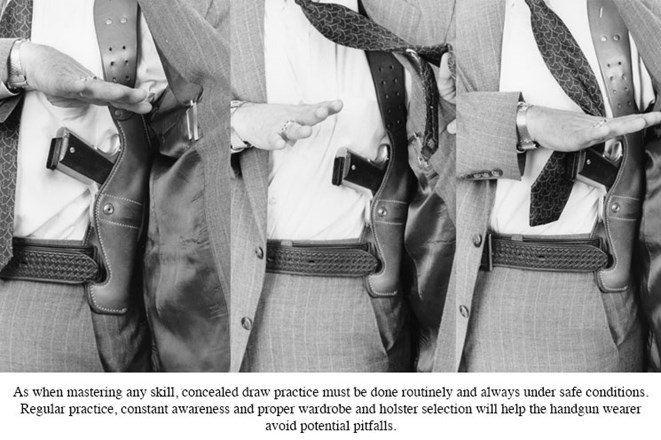 Either the tie finds its way between the thumb and forefinger of the drawing hand, particularly when using a shoulder rig, or the thumb of the same hand slides under the buttoned shirt front, thereby short-circuiting the draw.
Either the tie finds its way between the thumb and forefinger of the drawing hand, particularly when using a shoulder rig, or the thumb of the same hand slides under the buttoned shirt front, thereby short-circuiting the draw.
Vertically mounted-right-hand shoulder holsters present another challenge for those wearing men's shirts. The best access to the backstrap of the pistol in such a rig is achieved by thrusting the pronated right hand downward from above shoulder level while jutting forward the left shoulder to position the pistol as far forward as possible to allow for proper hand engagement.
Several times while practicing this type of draw, my thumb has torn the shirt's left front breast pocket nearly off the shirt. This does not occur if one is left-handed and working to the right simply because most shirtmakers do not incorporate a pocket on the right breast. Perhaps the best solution is to remove the pocket before wearing the shirt.
When wearing a belt rig, efforts should be made to keep excess shirt material and the tail tucked well into the waistband of the trousers. Grabbing a handful of shirttail in addition to your pistol then requires quick action to preclude dropping the pistol as the draw is completed, The excess tail in your hand becomes tight as the draw continues until it pries the fingers open (unless you are strong enough to tear the shirt) and away from the pistol, releasing it to fall on the ground.
The vest of a three-piece suit presents a similar problem in that proper positioning of the drawing hand brings the four curled fingers (thumb excluded) close to the bottom edge of the vest in the latter stage of-the circular scooping motion just before gripping the pistol. Should the curled fingers hook the bottom of the vest while the thumb and forefinger close on the pistol and begin to remove it from the holster, the result at least will be a delayed draw; or possibly a dropped pistol; Don't say it can't: happen; it has.
Today's detectives and bodyguards, like their uniformed counterparts, carry a plethora of equipment. In addition to pistols and portable radios, they wear spare ammunition, handcuffs* black-jacks/slappers and key rings. Many, civilians who legally carry pistols may also be similarly burdened while engaged in their vocations.
Long hours of standing can and do, result in lower back problems. As a partial solution, many have resorted to the wearing of suspenders. If you do, or are anticipating their use be aware that suspenders, too, may interfere with the concealed draw.
I find that about a third of the time when I'm wearing them, the little finger of my strong hand catches on the leading edge of my right front suspender strap as I sweep back my jacket. You guessed it, again a bungled draw, or a clumsy stabbing second effort. Neither is acceptable-and both erode confidence. Sometimes even a cross-draw will be aborted as the opposite suspender strap becomes the offender. I admit I've developed "no sure cure, but perhaps snapping the front straps closer toward the midline of the body (buckle area) may help a bit.
Carefully planning your choice of holsters and wardrobe will help avoid the pitfalls enumerated here. In addition, practice wearing “street” clothing, holster and pistol. Be constantly alert to potential and/or developing pitfalls. Practice on a routine basis, practice safely and always remember that the concealed draw is a specialized skill. Mastering it will bring confidence to any person who by virtue of his vocation or local conditions must wear a concealed pistol.
The opinions or assertions contained herein are the private views of the author and are not to be construed as official or as reflecting the views of the Department of the Treasury or the United States Secret Service.












